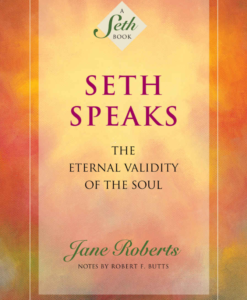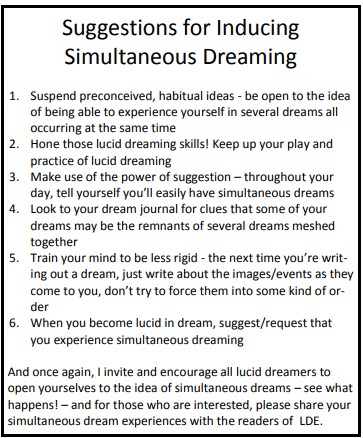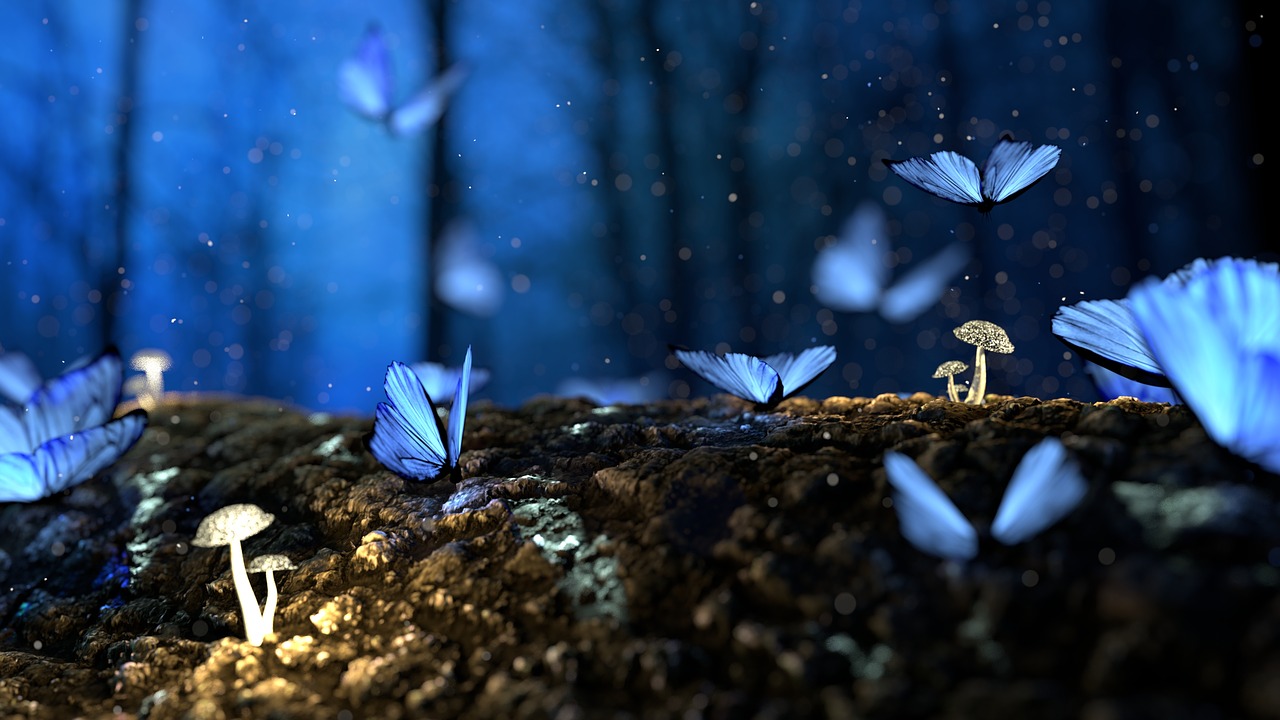By Lucy Gillis © 2012
WTF Was That?!
I first encountered simultaneous dreaming in 1988. It completely blew my mind! I had never experienced anything like it before and was at a loss for an explanation. I had been in two dreams at the same time but not only that, I was lucidly aware of being in the two dreams while they were happening.
I was fully focused and engaged in each dream, with no breaks or switching of awareness from one to the other. One dream didn‘t feel any more prominent than the other. Each dream was complete in itself, and for that matter, so was I – I was complete too. I didn’t feel I was ‘split‘ or that I was two different people, despite being in two different dreams at once. ‘I‘ didn’t feel any different at all.
 The whole experience felt very powerful, very clear, and yet, what was most incredible of all, it felt perfectly natural – up until the point where I became frightened by even having such a strange occurrence and forced myself to wake up. Unfortunately, it would seem that it was my lucid awareness of the situation that allowed ‘fear of the unknown‘ to enter into the experience causing me to cut the whole thing short.
The whole experience felt very powerful, very clear, and yet, what was most incredible of all, it felt perfectly natural – up until the point where I became frightened by even having such a strange occurrence and forced myself to wake up. Unfortunately, it would seem that it was my lucid awareness of the situation that allowed ‘fear of the unknown‘ to enter into the experience causing me to cut the whole thing short.
Eventually, I was fortunate to come across a reference regarding this sort of dreaming in a Seth book by Jane Roberts. Seth, ‘an energy essence personality ‘ channeled through Jane, spoke extensively on a variety of subjects with a considerable amount of material devoted to dreams and dreaming.
From The Nature of the Psyche:
‘Many people are aware of double or triple dreams, when they seem to have two or three simultaneous dreams. Usually upon the point of awakening, such dreams suddenly telescope into one that is predominant, with the others taking subordinate positions, though the dreamer is certain that in the moment before the dreams were equal in intensity.’
We Are Not Alone
Besides the topic of dreaming, Seth also spoke extensively on the multidimensional nature of consciousness, reality, and personality regarding the existence of what he called probable realities, probable events, and probable selves (i.e. parallel universes, parallel events, and parallel selves).
 Seth maintained that we exist in a system of probabilities where all potential events exist simultaneously. In our present physical reality we actualize/ experience one event, while all probable versions of that event are actualized in other realities.
Seth maintained that we exist in a system of probabilities where all potential events exist simultaneously. In our present physical reality we actualize/ experience one event, while all probable versions of that event are actualized in other realities.
He also explained that while each of us has a sense of identity that is ‘me‘ (the ‘recognized self‘), we also have alternate selves in existence too. In other words, though I identify and know myself as ‘me, Lucy‘ there are other ‘Lucy‘s‘ in other realities; some very similar to me, others quite different, possessing talents, abilities, skills, knowledge, etc. that may not appear dominant in my ‘recognized‘ personality.
According to Seth, all these me‘s – all these Lucy‘s – are ‘quite as legitimately the same identity’ but only one (the ‘me‘ that I know; my recognized self) is usually focused upon. However, we all have the inherent ability to tap into this rich reservoir of our multidimensional identity, and draw upon these other abilities, skills, insight, etc., that our probable selves possess.
This notion of parallel universes and parallel selves is not unique to Seth. In 1957, physicist Hugh Everett had proposed a similar idea known today as ‘The Many Worlds Interpretation of Quantum Mechanics,’ a theory that has been steadily growing and developing among physicists and cosmologists ever since.
Currently, most scientists believe that these parallel universes are completely separate from each other. However, according to Seth, we are not entirely cut off from these other realities or our other selves at all. He maintained that at certain ‘levels‘ the dream state serves as a connective between the various probable selves and that:
‘On some occasions in the dream state the recognized self may then enlarge its perception enough to take advantage of these other portions of its own identity. Double or triple dreams may represent such encounters at times.’
(It is important to note that Seth did not state that every simultaneous dream experience represented a contact between parallel selves; this is just one example of when/why such dreams may become evident.)
But Is There Anybody Else Out There . . . Right Here?
After I had my first simultaneous dreams, I could not find anyone who had had a similar experience (apart from a few people mentioned in the Seth books). When I wrote about simultaneous dreaming, I put out a call to others asking those who had had this experience to share their stories with LDE.
In the beginning there was basically no response, but as the years went by, eventually a small number of people got in touch and told me about their encounters with simultaneous dreaming. It seemed the phenomenon, though rare, was very slowly becoming less obscure.
Of the few who wrote, some asked if I knew of any induction methods or techniques that might help them have more dreams of this nature.
At first, I had no idea – other than making use of the power of suggestion – until I began to pay attention to the process of recalling and writing down my dreams. It was then that I realized that maybe I could make use of some more of Seth’s information:
‘In double dreams and triple dreams consciousness shows its transparent, simultaneous nature. Several lines of dream experience can be encountered at the same time, each complete in itself, but when the dreamer wakes to the fact, the experience cannot be neurologically translated; so one dream usually predominates, with the others more like ghost images.’
My Own Uncertainty Principle
I had noticed that on certain occasions when recording a dream in my dream journal, I would have difficulty piecing various scenes and images together. I couldn‘t work out the ‘correct order‘ of dream events, and some scenes didn‘t seem to fit the dream at all – they were like TV commercials that pop up and interrupt the flow of a movie.
Of course dreams can be jumbled and bizarre anyway, but these particular dreams felt different somehow in a way that is hard to explain, yet the feeling is definitely different from a ‘usual‘ bizarre dream. In these types of dreams, I could feel the images slipping and sliding about in my mind, in constant motion, as though they were all jockeying for the same position.
The more I strained to recall, the more confused my memory of the dream became. Some scenes faded fast from memory while I tried to mentally manipulate their ‘position‘ in time until they were like the ghost images that Seth described, with some fading away entirely. It seemed that the harder I tried, the less I could clearly recall.
So to preserve as much dream recall as I could, (and to save myself some frustration) I quickly learned to preface those particular ‘slippery‘ dream accounts with capital letters ‘OU‘ (Order Uncertain), before proceeding to write down any details as they came to me, regardless of whether they seemed out of order, or out of context, or not.
Amusingly, in a way vaguely reminiscent of Heisenberg‘s Uncertainty Principle* of quantum physics, when the dream events seemed like they were in constant motion, I couldn‘t nail down their positions in linear time, and when I did (artificially?) assign a position to them, I lost the flow, the momentum of the dream drama(s).
It took me a while, but eventually, as I encountered more of those particular ‘slippery dreams,‘ I caught on to what was likely occurring. I finally recalled what Seth had said about two or more dreams telescoping into one, and I realized that this was probably what was happening: I was attempting to fit images and scenes into some linear order – into one sequence of events – when originally there may have been more than one sequence of events occurring at the same time.

Image by Pexels from Pixabay
The Lucidity Advantage
But why didn‘t this happen when I had my first recognizable encounter with simultaneous dreaming? At that time, my two dreams didn’t telescope into one predominating dream – I was able to remember both, and to remember them as occurring at once, equal in intensity. I can still remember that incredible, but natural feeling of being in two places at once.
Now, the answer seems so simple. The difference between my original encounter and my subsequent ‘slippery‘ dreams, was that in the case where I could keep the simultaneous dreams separated in memory, I had had lucid awareness of the situation during the experience.
Obviously, to be aware of simultaneous dreaming, while it is happening, you have to have some degree of lucidity to even recognize that what you are experiencing are dreams; that you are in a dreaming environment and not in your usual state of wakefulness.
When I was having my ‘slippery recall‘ difficulty, it may well have been because I had just had simultaneous dreams, but was either not lucid at all while having them, or was losing and forgetting lucidity entirely on waking, as I tried to remember what I assumed was only one dream.
In forcing myself to wake up during my original encounter with simultaneous dreaming, it would appear that my lucid awareness cut short my experience. However, it could be argued that if it wasn‘t for my lucidity, that unusual experience may never have been recognized for what it was – simultaneous dreaming.
Without lucid awareness, I may never have ‘caught myself‘ operating in two dreams at once. Upon waking, my simultaneous dreams might have collapsed – via Seth‘s telescoping effect – into the appearance of one dream, and I would have been none the wiser – I would not have any memory or indication of this extraordinary experience.
It’s About Time
I believe that the phenomenon of simultaneous dreaming is not as rare as it may at first appear. I believe that simultaneous dreaming is a frequent or even constant occurrence, going on just underneath the surface of our awareness, but because we are so habituated to experiencing time in a single, linear progression, we fail to bring this awareness to waking ego consciousness.
Our propensity for remembering ‘the order of events‘ in a linear sequence, (as well as our identification with being a singular self) may inhibit our ability to recall – much less even perceive – multiple series of events that are occurring simultaneously.
If in waking, we do indeed ‘step down‘ from functioning as a multidimensional identity, to a ‘singular‘ focused ego-awareness, then how many dreams do we ‘forget‘ or distort, simply because our idea of time/identity is so singular?
If we‘re limiting or blocking concurrent dreams because we try to squeeze them down to something less than they really are, what else could we be missing out on? What other perceptions or inner senses could we be blocking from ourselves?
Is all this sounding strange?
And of those who had heard of lucid dreaming, there were many who believed they were not real – that it is was impossible to be awake inside a dream; to essentially be awake and asleep simultaneously. It was thought these so-called lucid dream experiences were just hyper-vivid dreams, hallucinations, or even delusions, until lucid dreaming pioneers Keith Hearne and Stephen LaBerge both independently proved through scientific means that lucid dreaming is indeed a real phenomenon; that you can most certainly be awake in your dreams, while your body sleeps.
 Similarly, the idea of parallel worlds was also mostly unheard of except in light of science fiction stories. Granted, we haven‘t any hard scientific evidence of parallel universes or parallel selves. Yet. But with the developing theories in quantum physics and cosmology, coupled with our everadvancing technology, it may only be a matter of time.
Similarly, the idea of parallel worlds was also mostly unheard of except in light of science fiction stories. Granted, we haven‘t any hard scientific evidence of parallel universes or parallel selves. Yet. But with the developing theories in quantum physics and cosmology, coupled with our everadvancing technology, it may only be a matter of time.
Besides scientific discoveries, the rapid acceleration in global communication technology, social media, self publishing, etc., has propelled the once virtually ‘unknown‘ phenomenon of lucid dreaming into a more mainstream public awareness. The same can be said for the subject of parallel universes, (and parallel selves).**
At present, simultaneous dreaming seems to be a rare phenomenon and is practically unheard of by the vast majority of our world. But just as public awareness of lucid dreaming (as well as parallel universes) is becoming more commonplace, it‘s my belief that we will eventually see a similar trend with simultaneous dreaming.
To accurately describe simultaneous dreaming is a challenge in itself. As with the act of lucid dreaming, until you experience it first hand, even the most detailed descriptions will not do it justice. But once you experience simultaneous dreaming for yourself, then you know, you fully understand what it is like to be in two or more ‘places‘ at once with full and undivided focus on each. And that is a truly mind-expanding experience no adventurous, pioneering lucid dreamer should miss out on!
* Very briefly, Heisenberg‘s Uncertainty Principle states that it is not possible to accurately measure a particle‘s position and momentum simultaneously.
** The Fabric of the Cosmos (Book and DVD) by Brian Greene; Parallel Worlds, by Michio Kaku; ‘Are There Parallel Universes?’ Episode of TV Series: Through the Wormhole, narrated by Morgan Freeman; to name only a few popular examples.






